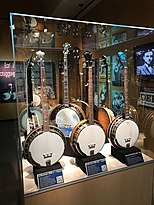Prewar Gibson banjo
This article needs additional citations for verification. (February 2019) |

Prewar Gibson banjos were made in the years before World War 2. They are differentiated from later Gibson banjos by their scarcity. Banjo sales plummeted during the Great Depression, for lack of buyers, and metal parts became scarce into the 1940s as factories shifted to support the war. As parts became scarce, non-standard versions came out, made from a variety of leftover parts, called floor sweep models.[1]
Terminology[]


Although this term normally refers to World War II, when used to describe Gibson banjos, the term prewar operationally refers to banjos made prior to 1947. Production of metal banjo parts was suspended during World War II. However, small numbers of Gibson banjos continued to be constructed and shipped during the war years using stocks of metal parts remaining in factory bins. For that reason, Gibson banjos produced between 1940 and 1945 often reflect the creativity of shop personnel rather than standard catalogue descriptions.[2] Production of metal banjo parts resumed in the Fall of 1946; however, it is commonly believed that the metal composition of foundry products delivered to Gibson after World War II was inferior to that of parts produced prior to 1940. On April 12, 1947, the Gibson Instrument Company changed their corporate logo from script lettering to the use of block letters, and this change occurred sufficiently close to resumption of banjo output to allow easy identification of prewar and postwar Gibson instruments.
Identifying a prewar Gibson banjo[]
Determining the authenticity of a prewar Gibson banjo can be a real challenge for a variety of reasons:
- The Gibson company produced a fairly wide variety of .
- Prewar Gibson banjos frequently failed to conform to the standard catalogue specifications, by dint of cost-saving measures to diminish inventories of excess or less-than-desirable components, thus casting doubt on the deviant banjo's authenticity.
- The actual number of authentic banjos is relatively small, so the experience of examining and playing them is limited to comparatively few individuals.
- Demand for these instruments is high, which has led to significant efforts toward reproducing them, with varying degrees of success.
- The majority of these banjos have been modified in some way by their owners over the years, due to the adjustability of the components, changes in playing style, etc.
References[]
- ^ Gibson RB-4 - 1929 (Plaque beneath museum exhibit). Oklahoma City, OK: American Banjo Museum.
banjo differs from typical Gibson production in 1929 and was completed in 1930s from parts found around the Gibson factory - a 'floor sweep' model
- ^ "Banjo Newsletter". Banjonews.com. Retrieved 21 February 2019.
External links[]
- Greg Earnest's site contains an overview of the various Gibson banjo styles, with many detailed photographs of vintage Gibson banjos.
- Dan Foy's site has an extensive reference list of pre-war Gibson banjo serial numbers.
- Spann's Guide to Gibson 1902-1941 is a, "detailed look at the inner workings of the famous musical instrument manufacturer of Kalamazoo, Michigan before World War II." (back of cover)
- Gibson Guitar Corporation